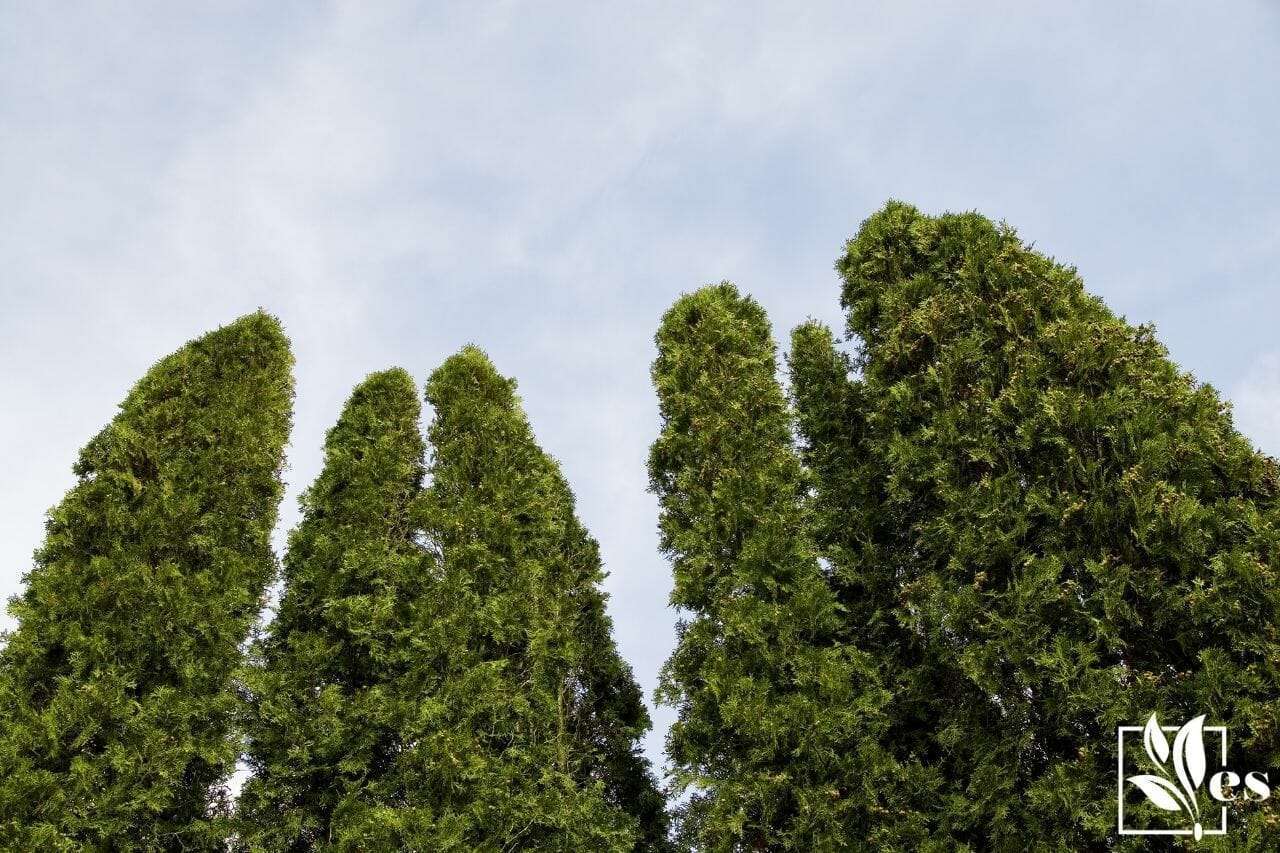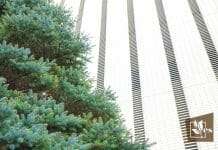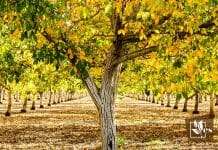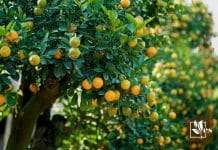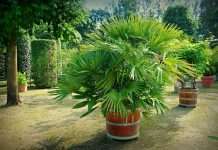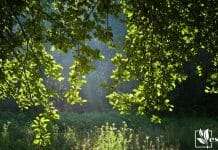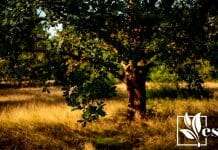- When to Plant Zucchini in Maryland: Optimal Times for Success - June 27, 2024
- When to Plant Grass Seed in Austin TX: Best Seasons and Techniques - June 27, 2024
- When to Plant Butternut Squash in NC: Best Times and Tips for Success - June 27, 2024
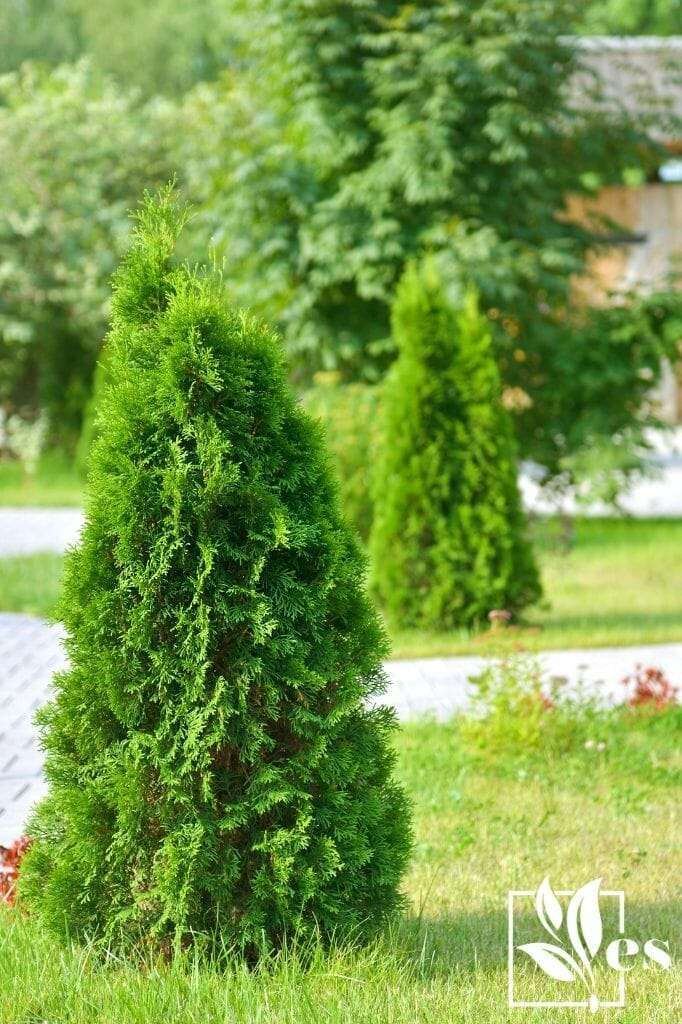 Green Giant Arborvitae, also commonly known as Thuja, is a conical plant that is quite popular among many hobbyists on account of its high resistance to pests, droughts, and diseases.
Green Giant Arborvitae, also commonly known as Thuja, is a conical plant that is quite popular among many hobbyists on account of its high resistance to pests, droughts, and diseases.
Arborvitae is also a much-revered plant for its ability to grow in harsh weather conditions while still maintaining the vibrant emerald green of the foliage all year long.
Among other things, these evergreens that are native to America are a great choice for hedgerows, which is why you might find some lining the sides of driveways or fences.
For this purpose, it is important to know about the proper spacing of these plants, which our expert guide will discuss here.
JUMP TO TOPIC
What Is Green Giant Arborvitae Spacing?
For best results in terms of growth rate and health of the plants, green arborvitae should be planted no less than 5 feet from one another. If you plan to plant only a single but dense row, the optimal distance is 5 to 6 feet. For staggered rows, 6 to 8 feet is the way to go.
How to Space Green Giant Arborvitae
If you would like your shrubs to grow in a pyramidal or conical shape, try planting them 14 feet apart. Remember that the bigger the green giant trees’ spacing, the faster and larger your trees will grow, so make sure you do not plant anything underneath them and keep them out of the way of power lines.
Read on to learn more about optimal spacing for different needs, and what you need to consider before undertaking this project. This way, the end results will be nothing short of perfect!
Based on the way you plan to plant your thuja green around your property, how to go about planting the green giants will vary. Spacing measurements for the most common uses of emerald green arborvitae, such as single rows, hedgerows, staggered rows and specimen trees are as follows.
– How to Space for a Single Row
Regardless of where you plan to plant your thuja green giant on your property, whether it is on the side of your walkway or to line your garden, single-row planting is the easiest option. If you are okay with your emerald green arborvitae not necessarily growing into hedgerows as fast as possible, leave 5 to 6 feet between each tree.
However, if you are planting the thuja green giant to form solid hedgerows, plant them no more than 3 feet apart. Thanks to their fast-growing property, your single row will grow into emerald green hedgerows in no time.
One thing to note, however, is that planting thuja green giants 3 feet from each other may sully the quality and health of the trees themselves.
– How to Space for Staggered Rows
Staggered rows are a spin on the traditional row, where instead of a single line, planting is done diagonally. Staggered rows are another great way to plant these trees because doing so maximizes how many trees you can plant without taking up too much space.
In addition to allowing for more planting in less space, diagonally planted rows of the “green giant” are a great way to create a privacy screen around your property.
If diagonal rows are what you have decided on, the optimal distance is 6 to 8 feet between each plant.
– How to Space for Specimen Trees
As the name suggests, Specimen trees or plants are those that are meant to be the focal point of interest in a garden. If you want your garden to instantly catch people’s attention, arborvitae makes a great choice of specimen trees.
Simply put, there is no right way to plant trees when they are meant only for their aesthetic appeal, and now to serve a designated purpose. With this type of planting, the choice is entirely yours, but it will do you well to remember that when planted singularly, these trees can grow to a whopping 12 to 20 feet in width!
So when you are making the holes to plant thuja trees, keep in mind the width and height to which they are likely to grow.
A Rundown of Important Considerations
You may think you are ready to start growing trees on your property, and while you are well on your way, there are still some considerations to take into account.
– Where to Plant Your “Green Giant” Trees
WHere you will plant your trees depends on what you need them for. Whatever the best place to plant your thuja green is contingent on why you are planting them in the first place.
– Planting for Privacy
If your reason for planting thuja green giants is to protect your property from prying eyes, walkways, driveways, fences, and property lines are the best place to grow these trees.
– Planting as Focal Pieces
If you are planting these evergreens to be looked at, then the best place to plant them is wherever you decide!
As long as the trees are planted in areas that have unrestricted access to sunlight and only receive limited shade, you are good to go!
– “Green Giant” Tree Height
Before you get to landscaping for evergreens, it is a good idea to map out how tall you want your trees to grow. If you like your trees tall, make sure to leave as much space between every two trees as possible. The opposite is true if you want a shorter height: the less space between two plants, the more shrub-like growth you will achieve.
If you want your arborvitae to grow as tall as they possibly can, it will do you well to space them out as much as possible. If your property allows for it, space them as much as 20 feet from one another.
If you are not a fan of literal giant evergreens on your property, spacing them 10 to 15 feet apart will give you half the height, so you can still enjoy relatively tall trees without altering your skyline.
– Hedgerows
Hedgerows are one of the most common uses of Thuja greens, second only to growing large trees for Christmas. Therefore, it is important to map out ahead of time where you want your hedgerows to grow and space them accordingly.
The closer the spacing, the more dense your hedges will be, and the faster they will grow.
– Time
Arborvitae growth can vary greatly. Sometimes, a full hedge takes as little as a year or two to grow into thick hedgerows. In other instances, these magnificent trees can take as long as 5 years to be dense enough to provide privacy.
As mentioned countless times, thujas have an incredibly fast rate of growth — faster than most other evergreen species. In most cases, they have a growth rate of approximately 3 to 5 feet per year. To add to that, these trees can keep growing for over decades, and sometimes even more!
The oldest, fully mature trees can measure up to a staggering 50 feet in height!
– Thick Privacy Screen vs. Spaced Far Apart
The two main ways of planting Thuja plants are hedgerows for privacy or widely spaced trees so that they grow as tall as they possibly can. As with most other things, both ways of planting have their pros and cons, and if you need help deciding which way is right for you, we discuss both aspects below.
– Arborvitae as Privacy Curtains
Privacy curtains can easily and instantly be created by planting thujas close together; either in straight lines or diagonally, creating a dense cover that prying eyes cannot see through. When planted closely, usually some three to six feet apart, these trees will grow into dense hedgerows faster than any other species of evergreens.
However, the catch is that because they grow so fast, they require a lot of regular maintenance work. You may find them in need of pruning multiple times a year to keep them looking kept and tidy.
– Arborvitae Planted for Full Growth
The biggest benefit of planting thuja evergreens to grow to their full height is the visual touch they can add to your property.
The emerald green canopy of large conical trees can provide for a breathtaking, majestic view and add greatly to the look of your estate overall.
Tips for Planting Arborvitae Trees
If your soil is really compact, try tilling before making each individual planting hole(s). Planting a new tree can be done at any point in the year, but the best time is in the spring, before it gets really hot and you still have a full growth cycle before winter to create a healthy root system.
– Planting Process
In the first growing season, freshly planted evergreens will require plenty of water to build strong roots. Before you begin, make sure the Green Giant’s roots are completely submerged in water in the nursery pot.
– Remove the Root Ball
Slide the root ball out of the pot by turning it on its side. If the plant gets stuck, you can free it by slipping a long-bladed knife around the interior edge. Pull part of the roots outward from the sides and bottom of the root system so they don’t encircle the root. Unless the roots are coiled around the pot’s diameter, there should be no need to prune them.
In that instance, the troublesome roots should be trimmed so that when they are planted, they grow outward rather than in a circle. Dig a hole twice the width and a little deeper than the Green Giant’s container. No evergreen fertilizer or additives should be used.
– Plant the Root Ball
Place the middle of the root system on top of the mound, spreading roots out in every direction around the hole, then thickly layer up some soil in the center of the hole, 3-6 inches high. Start filling up the hole you made.
Avoid lowering the top of the root system lower than it was in the previous nursery container while backfilling. It’s possible that you’ll have to pull the plant up when you backfill. Immerse the hole with water once it is half-filled. After the water is removed, make any required adjustments to the stem’s depth and finish filling up the hole.
To ensure there are no air pockets surrounding the roots of the plants, gently push the soil surface surrounding the root ball down with your hands.
– Mulch and Water
Mulching is necessary to keep newly planted arborvitae trees moist. Construct a 3-6 inch tall earth dike around the perimeter of the root zone on the surface. As the water descends into the earth, it will impound over the roots. Make sure to give your trees plenty of water.
To assist retain soil moisture and limit weed infestation, spread a natural mulch 3-6 inches deep over the root system and beyond. Good options for natural mulch include:
- Hay
- Straw
- Leaves
- Pine needles
- Bark or wood chips
- Grass clippings
- Compost
Maintain a distance of 3 to 4 inches between the mulch and the trunk. Do not add any fertilizer at this point.
– Follow Care Requirements
For the first 2 to 3 months, water daily or every two days until the plants are rooted. Afterward, one inch of water should be given for a week or ten days. If your soil is particularly sandy or you’re experiencing a dry spell, watering more frequently with an expanding hose will help enormously.
In arborvitae, drought tolerance is high once the huge trees have rooted themselves. Lack of water is the most common cause of death in newly planted trees. Your thuja bush will require around an inch of water per week, whether from rain or irrigation.
To shield the roots from withering out, freezing or scorching, and to kill weeds, replace the mulch layer as needed. Use a natural mulch to supply nutrients to the soil as it decomposes. Maintain a mulch layer around the tree that is 3 to 6 inches deep at all times, but maintain a distance of a couple of inches from the trunk.
– Prune
Thuja plants will grow into a grand pyramidal shape with thick leaves all the way to the floor if not pruned. It can be pruned to match your needs after the first year of growth. You’ll need to shear your hedge numerous times during the growing season to keep it in a low form.
– How To Select the Right Site for Planting Arborvitae
These evergreens thrive in full sun to light shade on moist, fertile and well-drained loamy soils. They will not grow in damp, poorly drained, or constantly wet soils, and they do not take well to heavily compacted soils.
In USDA planting zones 5 and 6, a minimum of 6 to 8 hours of direct sunlight is ideal; in tropical climates, a little shade, particularly in the afternoon, won’t hurt. If you are in doubt, always conduct a soil test.
The giant green bush is a magnificent sentinel tree with few contenders. A pair of these giant evergreens on opposite sides of the yard will provide a majestic frame for your garden.
Place a clump of multiple thuja bushes in a larger yard or garden for a wonderfully magnificent point of focus. Arborvitae trees should be spaced 5 to 6 feet apart for a live screen or hedge, a windbreak, or a snow break. Place them in 2 rows, 4 feet apart, with each tree staggered 8 to 15 feet apart inside each row, creating a uniquely green and huge hedge.
Any structure, driveway or road must be at minimum 6 to 8 feet away from the row(s). All these steps are critical to ensure that landscape trees reach their full potential.
– How to Care For Arborvitae Tree
Arborvitae may thrive in a variety of soils, even hard clay. Although the plant prefers well-drained soil, it is not essential. A coat of mulch around the bottom of the plant is recommended to assist in locking in moisture and shielding the roots from harsh weather.
Fertilizing is not required. However, you can fertilize with a regular evergreen fertilizer in the early spring if you want to. It is not required to prune these evergreens. You may cut the plants once per year if you plant them as a hedge, but take note that is preferable to do this after the last frost has passed.
Because these plants grow so tall, it is better to plant a different arborvitae species rather than just the Green Giant and then have to prune it all the time if your space cannot manage it.
– Planting Tips
Here are some more planting tips that may come in handy:
- Make sure you are starting off on the right foot by using only the highest quality growing mediums for your trees.
- Make sure that whatever area you choose to plant your evergreens receives ample amounts of sunlight throughout the year.
- Make sure you keep up with the health of your trees during their growth phases by regularly fertilizing and providing them with food.
- Make sure you set a watering schedule for your trees and stick to it diligently.
- Make sure you pay extra attention to pruning and shaping hedges to always keep your thujas looking the best.
What Is Plant Spacing?
Plant spacing refers to the arrangement of plants in a set area that they are planted, and it is a crucial calculation that should never be overlooked. Every species of plant has its own specific requirements in terms of the room they need to grow properly.
– Importance
There are a number of good reasons why ensuring there is just the right amount of room between every two plants in your garden is so critical. When done correctly, plant spacing will:
- Make it so your plants do not have to compete for sunlight, which is vital for plant health and their growth
- Help your soil conserve water, since all the soil around your plants will be in the shade
- Ensure that no two plants have to compete for nutrients from a limited patch of soil, and that all plants get as much of the nutrients from the ground as possible
- Help you manage and reduce the amount of space in your garden so that there is little to no room for weeds to grow
Even if you add more nutrients to your garden’s soil, it’s far better for your plants if they don’t have to compete for the nutrients that are already present. Leaving the proper amount of space between your plants is significantly better for them.
– Plant Spacing Calculators
If you’ve never planted a garden before and aren’t sure how to figure out optimum plant spacing, you might find that using a plant calculator makes the work a lot easier. Do not fret about having to use a plant spacing calculator for help until you get the hang of it and know how to space for any type of plant like the back of your hand.
A simple web search will present you with a plethora of calculators, all you have to do is fill in the information about the area to be planted and the distance between plants and the calculator will take care of the rest.
– Can You Plant Green Giants With Small Spaces in Between?
Thuja plants can definitely be planted with smaller spaces between two trees, such as 3 feet apart, but keep in mind that this will limit the growth of the trees to around half of their true potential height.
– Is It Possible To Keep Green Giant Arborvitae Small?
It is definitely possible to keep these trees small, but this calls for a lot of patience as well as work to be put in. It is, after all, in these trees’ nature to grow out as tall as possible.
To keep arborvitae small, you will need to practice their upkeep regularly and prune and shape the plants multiple times a year for the results you want.
Arborvitae Tree Guide
While it is fair for a landscaping aficionado to go right ahead with planting this tree as they please, it is prudent for the amateur to carefully plan beforehand. When planning, remember to keep these trees’ growth rate, size and shape in mind.
Most importantly, green giant arborvitae spacing is an especially crucial consideration. Here is some more important information to take into consideration when planning to plant these trees.
| Scientific Name | Thuja (standishii x plicata) ‘Green Giant’ |
| Watering | Medium |
| Growth | Conical |
| Features | Interest Year-Round |
| Flower Color(s) | None |
| Bloom Period | Grown for Canopy |
| Foliage Color | Green |
| Light Exposure | Full Sunlight |
| Height | Full: 40 to 60 Feet (may be shorter depending on spacing) |
| Width | 12 to 18 Feet
(may vary depending on spacing) |
| USDA Hardiness Zones | 5 to 8 |
- Zones: The arborvitae tree can be expected to grow in Zones 5 to 7.
- Size at Maturity: This evergreen can usually grow to a height of 50 to 60 feet and a span of 12 to 20 feet at maturity.
- Rate of Growth: This tree grows at an incredibly quick pace, with annual height increases of more than 24 feet.
- Light Requirements: Direct sunlight and the occasional partial shade are best for this tree, which is to say the plant thrives when it receives a minimum of four hours of direct, unfiltered sunlight each day.
- Soil Preference: This evergreen species can tolerate a wide array of soil textures. However, it’s better to steer clear of inadequately drained and water-logged grounds. In addition, the plant is very sensitive to salt.
- Until maturity, the plant will grow up to 3 feet per year.
- In the winter, it darkens or bronzes significantly.
- Pruning isn’t necessary, but the tree can be sheared if needed.
- Is a public domain tree, which means it can be propagated from cuttings by anybody.
- There are no severe diseases or pest issues that this tree encounters.
- The tree features a flattened, fan-like spray of small, scaly, glossy green leaves clustered tightly together and in overlapping rows on split branchlets.

- Cones are 1/2 inches long and bloom green in the summertime before turning brown in the winter.
- When the leaves are pressed, they release a pleasant fragrance.
- Once rooted, they can tolerate wind and can resist heavy ice or snow, making it an excellent choice for a rapidly growing windbreak.
- Thujas are more resistant to deer browsing unlike many arborvitae.
- They form a pyramidal or conical shape as they grow.


